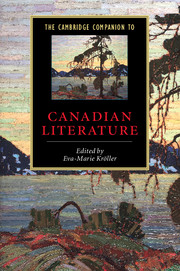Book contents
- Frontmatter
- Introduction
- 1 Aboriginal writing
- 2 Francophone writing
- 3 Exploration and travel
- 4 Nature-writing
- 5 Drama
- 6 Poetry
- 7 Fiction
- 8 Short fiction
- 9 Writing by women
- 10 Life writing
- 11 Regionalism and urbanism
- 12 Canadian literary criticism and the idea of a national literature
- Further reading
- Index
- Series List
8 - Short fiction
Published online by Cambridge University Press: 28 May 2006
- Frontmatter
- Introduction
- 1 Aboriginal writing
- 2 Francophone writing
- 3 Exploration and travel
- 4 Nature-writing
- 5 Drama
- 6 Poetry
- 7 Fiction
- 8 Short fiction
- 9 Writing by women
- 10 Life writing
- 11 Regionalism and urbanism
- 12 Canadian literary criticism and the idea of a national literature
- Further reading
- Index
- Series List
Summary
Introduction
In May 1951 Robert Weaver, the person in charge of literary programming for the Canadian Broadcasting Corporation's national radio network, bought broadcast rights for a short story called “The Strangers.” It had been written by a nineteen-year-old university student named Alice Laidlaw. After Laidlaw made some revisions, Weaver planned to broadcast it on 1 June on Canadian Short Stories, a fifteen-minute national program. But on 30 May he wired Laidlaw that “The Strangers” would not be broadcast as planned because the Massey Commission Report was to be released on the afternoon of 1 June; the story was broadcast later that year.
Though anecdotal, this coincidental moment is an apt point of departure for a discussion of the Canadian short story in English. Throughout his long career at the CBC from 1948 through 1985, through a succession of programs the most prominent of which was Anthology (1953–85), Robert Weaver encouraged scores of writers to develop the form in Canada. More than this, with William Toye and others, he produced the Tamarack Review (1956–82), the leading Canadian literary magazine of its tumultuous times, and also edited a succession of influential short-story anthologies beginning with Canadian Short Stories (1960) through a Fifth Series volume in 1991. Alice Laidlaw, the young writer from whom Weaver bought “The Strangers” – the first story she had ever sold – went on to marry in 1951 and become Alice Munro; throughout the 1950s and into the 1960s, times of struggle and frustration for Munro as a writer, Weaver would remain her primary connection to a literary world.
- Type
- Chapter
- Information
- The Cambridge Companion to Canadian Literature , pp. 177 - 193Publisher: Cambridge University PressPrint publication year: 2004
- 1
- Cited by

